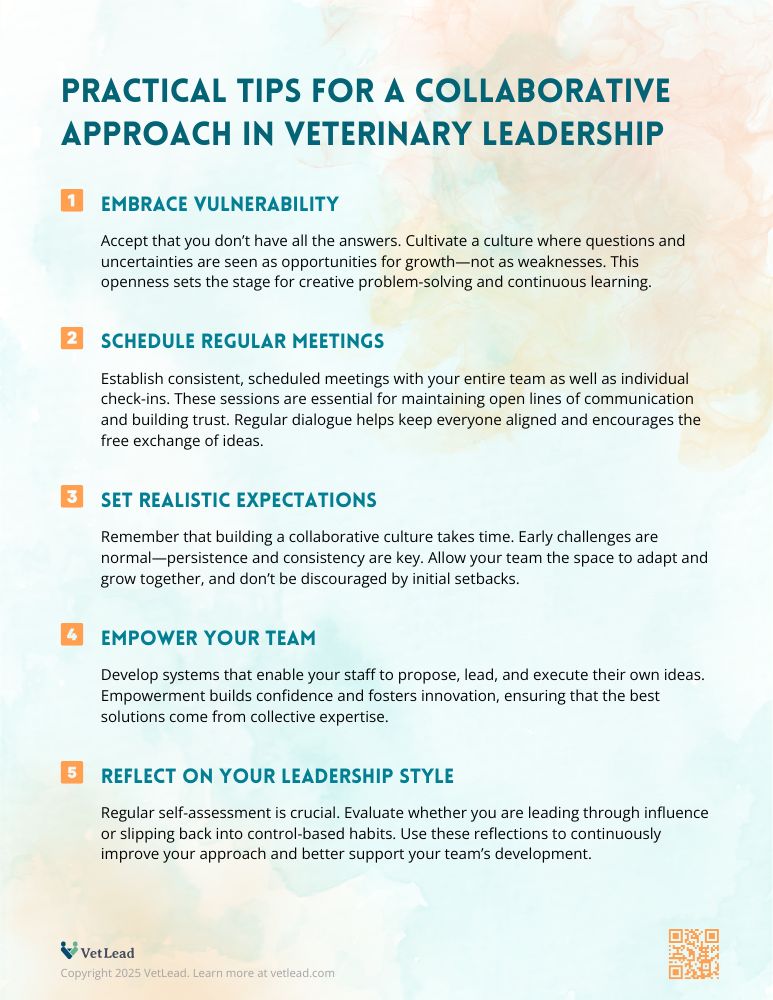Effective leadership in veterinary practice isn’t just about having all the answers—it’s about creating an environment where everyone contributes to a shared vision for success. Let’s dive into the concept of collaboration in veterinary leadership and share some insights on how to shift from a control-based mindset to one that genuinely embraces the strengths of your team.
Why Collaboration Matters in Veterinary Practice
In many veterinary practices, there’s a tendency to fall back on a compliant culture—where everyone follows orders without question. While that approach may offer a sense of order and predictability, it often stifles innovation and limits the full potential of your team. When you invite your team to share their ideas and contribute to decision-making, you tap into a diverse pool of experience and creativity that can lead to innovative solutions and improved patient care.
A collaborative environment offers several key benefits:
- Enhanced Engagement: When team members feel their opinions matter, they’re more invested in the success of the practice.
- Innovative Solutions: Different perspectives often lead to creative ideas that wouldn’t emerge in a top-down system.
- Sustainable Growth: A culture where everyone contributes is more adaptable and better equipped to handle change.
Ultimately, collaboration is about more than just delegation—it’s about building a resilient practice that thrives on the collective strength of its team.
The Challenges of Letting Go and Building Trust
One of the biggest hurdles in embracing collaboration is the challenge of letting go. As leaders, many of us have been conditioned to believe that our way is the best way. That control can create a sense of security, but it often comes at the cost of stifling the potential contributions of others. Letting go means accepting that sometimes the best ideas come from your team, not just from you.
This transition isn’t easy. It requires:
- Vulnerability: Allowing yourself to be open and admit that you don’t have all the answers.
- Humility: Recognizing that your role as a leader isn’t to control every outcome but to empower others.
- Trust: Believing in the capability of your team to make sound decisions, even if those decisions diverge from your own initial ideas.
It’s natural to worry that team-generated ideas might not be as strong or well thought-out as those you might have come up with on your own. However, experience has shown that when team members are given the space to contribute, the collective effort not only fills in the gaps but often exceeds the sum of its parts.
Strategies for Building a Collaborative Veterinary Culture

Transitioning to a collaborative culture involves deliberate strategies and consistent effort. Here are some key tactics to help foster a more inclusive, team-oriented environment:
Creating Open Communication
To build a collaborative culture, it’s essential to establish clear, consistent channels for communication. This means setting up regular team meetings—both formal and informal—that offer a platform for sharing ideas and providing feedback. One-on-one sessions are equally important as they build trust and ensure every team member feels heard, while maintaining an open-door policy encourages staff to approach you with their thoughts and concerns at any time.
Empowering Staff
Empowering your team goes beyond simply asking for ideas—it involves creating structures that enable initiative. Allow team members to take ownership of projects that play to their strengths and delegate decision-making roles to foster both confidence and accountability. Supporting your staff with the necessary tools and training is crucial so they can excel in their roles and drive the practice forward.
Setting Clear Expectations
A truly collaborative environment also thrives when everyone understands the shared vision and their specific role in achieving it. Clearly articulating the future you envision for your practice and explaining why it matters helps align the team, while defining each role ensures that everyone knows how their contributions fit into the larger picture. Regular feedback loops then allow the team to assess progress and make adjustments as needed. Together, these strategies pave the way for a resilient, adaptive practice that can successfully navigate change.
Leading Through Influence, Not Authority

True leadership isn’t about exercising power—it’s about guiding and inspiring your team. When you lead through influence rather than authority, you create an environment where ideas can flourish and everyone feels responsible for the practice’s success.
Consider this shift in perspective:
- From Directive to Supportive: Instead of issuing orders, focus on asking questions that empower your team to think critically and creatively.
- From Controlling to Coaching: Your role becomes one of a coach, providing guidance and support rather than micromanaging every task.
- From Isolated Decision-Maker to Collaborative Visionary: Embrace the fact that some of the best decisions are made when multiple perspectives are considered.
This approach not only enhances team performance but also enriches your own experience as a leader. When you step back and allow your team to contribute, you free up valuable time and mental energy that can be invested in strategic thinking and future planning.
Practical Tips for Transitioning to a Collaborative Approach
If you’re ready to make the shift toward a more collaborative leadership style, consider these actionable steps:
- Embrace Vulnerability: Accept that you don’t have all the answers. Encourage a culture where questions and uncertainty are seen as opportunities for growth, not signs of weakness.
- Schedule Regular Meetings: Establish consistent, scheduled meetings with both your team as a whole and individually. These sessions are crucial for maintaining open communication and building trust.
- Set Realistic Expectations: Recognize that building a collaborative culture is a process that takes time. Don’t be discouraged by early challenges; persistence and consistency are key.
- Empower Your Team: Create systems that allow team members to propose, lead, and execute ideas. This empowerment not only builds confidence but also fosters innovation.
- Reflect on Your Leadership Style: Regularly assess whether you’re truly leading through influence or if you’re slipping back into control-based habits. Self-reflection is vital for continuous improvement.

Download Practical Tips for Transitioning to a Collaborative Approach
Share it with leaders and teams. No email address required.
Implementing these steps won’t happen overnight, but with time and commitment, you can transform the way your practice operates and unlock the full potential of your team.
The Impact on Your Veterinary Practice and Personal Well-Being
Adopting a collaborative leadership approach can have far-reaching benefits—not just for your practice, but for you personally as well. By shifting away from micromanagement, you create an environment where your team truly thrives, with every member contributing their best ideas. Decision-making becomes a shared responsibility, driving collective success and empowering everyone to take ownership.
When diverse perspectives are welcomed, innovation naturally flourishes. A collaborative culture fosters creative solutions to complex challenges, allowing your practice to adapt and evolve in dynamic ways. This openness not only sparks innovation but also ensures that the most effective strategies emerge from the collective expertise of your team.
In addition, entrusting your team with day-to-day operations significantly improves work-life harmony. The burden of controlling every outcome is lifted, freeing you up to focus on strategic planning and your own well-being. Many leaders find that this shift brings a profound sense of relief, enabling you to lead with greater vision, passion, and a commitment to continuous improvement.
Creating Your Best Future Through Collaboration
Moving from a control-based leadership style to one rooted in collaboration demands vulnerability, trust, and continuous learning—but the rewards are immense. Embracing this shift creates an environment where your team excels, innovates, and grows, while enhancing operational efficiency and personal well-being.
Reflect on your leadership approach, and consider the benefits of a thriving, sustainable practice built on collective empowerment. For more insights and tools on veterinary leadership, explore the resources at VetLead and take that first step toward a brighter, more inclusive future.